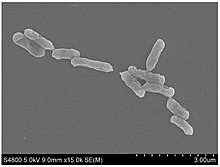Acidithiobacillus ferrooxidans is a bacterium that sustains its life cycle at extremely low pH values, and it is one of the very few organisms that gain energy from oxidating ferrous iron (Fe +II). It can make copper from ores water-soluble, and it can sequester both carbon and nitrogen from the atmosphere.[1]
| Acidithiobacillus ferrooxidans | |
|---|---|

| |
| An image of Acidithiobacullus ferrooxidans | |
| Scientific classification | |
| Domain: | Bacteria |
| Phylum: | Pseudomonadota |
| Class: | Acidithiobacillia |
| Order: | Acidithiobacillales |
| Family: | Acidithiobacillaceae |
| Genus: | Acidithiobacillus |
| Species: | A. ferrooxidans
|
| Binomial name | |
| Acidithiobacillus ferrooxidans (Temple and Colmer 1951) Kelly and Wood 2000
| |
| Synonyms | |
|
Thiobacillus ferrooxidans | |
A. ferrooxidans the best-studied of the acidophilic bacteria.[citation needed] During mining activities, the bacterium plays a crucial role in producing harmful acidic and metal-rich drainage water through the dissolution of sulfide minerals, but it also recovers precious dissolved metals.[2]
The gram-negative bacterium grows best at 30 °C at pH 2 and Fe 2+ concentrations of 10-1 M, but growth still occurs at pH values of less than 1.[1]
Genetics
editThe ATCC 23270 type strain has one circular chromosome of 2.9 million base pairs and a G+C content of 59%. Genome sequencing has shown 2070 genes that code for a protein with a known function, while 1147 hypothetical proteins have been found. The bacterium contains a gene that makes it toluene-resistant. Genes for chemotaxis and locomotion (flagella) have not been observed.[1]
See also
editReferences
edit- ^ a b c Jorge Valdés; Inti Pedroso; Raquel Quatrini; Robert Dodson; Herve Tettelin; Robert Blake; Jonathan Eisen; David Holmes (2008). "Acidithiobacillus ferrooxidans metabolism: from genome sequence to industrial applications". BMC Genomics. 9: 597. doi:10.1186/1471-2164-9-597. PMC 2621215. PMID 19077236.
- ^ Quatrini, Raquel; Johnson, D. Barrie (2019). "Microbe of the month: Acidithiobacillus ferrooxidans". Trends in Microbiology. 27 (3): 282–283. doi:10.1016/j.tim.2018.11.009. PMID 30563727. S2CID 56478481.
Further reading
edit- Raquel Quatrini; D Barrie Johnson (15 December 2018). "Acidithiobacillus ferrooxidans". Trends in Microbiology. 27 (3): 282–283. doi:10.1016/J.TIM.2018.11.009. ISSN 0966-842X. PMID 30563727. Wikidata Q90621279.
- Jorge Valdés; Inti Pedroso; Raquel Quatrini; Robert J Dodson; Herve Tettelin; Robert Blake; Jonathan A. Eisen; David S Holmes (11 December 2008). "Acidithiobacillus ferrooxidans metabolism: from genome sequence to industrial applications". BMC Genomics. 9: 597. doi:10.1186/1471-2164-9-597. ISSN 1471-2164. PMC 2621215. PMID 19077236. Wikidata Q33392439.
- Shuang Zhang; Lei Yan; Weijia Xing; Peng Chen; Yu Zhang; Weidong Wang (25 April 2018). "Acidithiobacillus ferrooxidans and its potential application". Extremophiles. 22 (4): 563–579. doi:10.1007/S00792-018-1024-9. ISSN 1431-0651. PMID 29696439. Wikidata Q57091863.
- Miguel A Campodonico; Daniela Vaisman; Jean F Castro; Valeria Razmilic; Francesca Mercado; Barbara A Andrews; Adam M Feist; Juan A Asenjo (19 March 2016). "Acidithiobacillus ferrooxidans's comprehensive model driven analysis of the electron transfer metabolism and synthetic strain design for biomining applications". Metabolic engineering communications. 3: 84–96. doi:10.1016/J.METENO.2016.03.003. ISSN 2214-0301. PMC 5779729. PMID 29468116. Wikidata Q50199378.
- Roumen Zlatev; Jean-Pierre Magnin; Patrick Ozil; Margarita Stoytcheva (11 October 2005). "Acidithiobacillus ferrooxidans fixation on mercuric surfaces and its application in stripping voltammetry". Biosensors and Bioelectronics. 21 (9): 1753–1759. doi:10.1016/J.BIOS.2005.09.001. ISSN 0956-5663. PMID 16223579. Wikidata Q46194750.